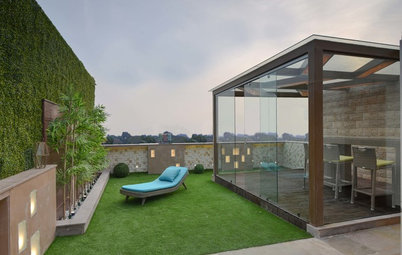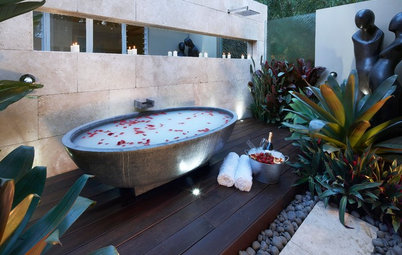6 Floors That Keep You Rooted in India
Add the edge of tradition to modern spaces with native Indian flooring materials that ooze an antique charm
Many parts of India have developed their own unique flooring, now intrinsic to their regional architectural vocabulary, depending on materials and skills available locally. Most such floors are eco-friendly, due to their natural composition and their response to the local climatic context.
Here is a collection of vernacular floors that go a long way in delivering an Indian vintage look to any space. If you are planning to add a dash of classical delight to your contemporary home, look no further than these floors.
Here is a collection of vernacular floors that go a long way in delivering an Indian vintage look to any space. If you are planning to add a dash of classical delight to your contemporary home, look no further than these floors.
2. Terracotta
Terracotta is a clay-based material known for its unique earthy appeal. Like Athangudi tiles, no two terracotta tiles are the same as they are made by baking red earth, which changes colour with age. Oxides can be added to the clay before firing to achieve different hues.
Terracotta is an important art and building material in Rajasthan, West Bengal and parts of Uttar Pradesh. Indeed, its use is spread right across rural and urban India for producing architectural elements such as floor tiles, roof tiles, paving blocks and bricks.
Terracotta, being porous in nature, requires annual sealing to resist stains and scratches. A properly sealed terracotta floor has a smooth finish, making it ideal for indoor use. While only handcrafted rectangular tiles were available earlier, now machines produce tiles of other geometrical shapes too.
The kitchen in the picture, designed by GJ Studio, contrasts red terracotta tiles with crisp white cabinets. The little motif pieces in the floor add to the Indian vibe.
Find an interior designer to help find the right floor for your new home
Terracotta is a clay-based material known for its unique earthy appeal. Like Athangudi tiles, no two terracotta tiles are the same as they are made by baking red earth, which changes colour with age. Oxides can be added to the clay before firing to achieve different hues.
Terracotta is an important art and building material in Rajasthan, West Bengal and parts of Uttar Pradesh. Indeed, its use is spread right across rural and urban India for producing architectural elements such as floor tiles, roof tiles, paving blocks and bricks.
Terracotta, being porous in nature, requires annual sealing to resist stains and scratches. A properly sealed terracotta floor has a smooth finish, making it ideal for indoor use. While only handcrafted rectangular tiles were available earlier, now machines produce tiles of other geometrical shapes too.
The kitchen in the picture, designed by GJ Studio, contrasts red terracotta tiles with crisp white cabinets. The little motif pieces in the floor add to the Indian vibe.
Find an interior designer to help find the right floor for your new home
3. Cuddapah
Black limestone or Cuddapah is a vernacular material of Andhra Pradesh. It can be distinguished by its near-black colour with grey speckles. It is a highly compact and a sturdy stone. It is resistant to temperature and pressure .
I love how the black stone makes a statement in this eclectic Goa residence designed by The Orange Lane. Here the Cuddapah has been teamed with wooden flooring and patterned tiles.
Black limestone or Cuddapah is a vernacular material of Andhra Pradesh. It can be distinguished by its near-black colour with grey speckles. It is a highly compact and a sturdy stone. It is resistant to temperature and pressure .
I love how the black stone makes a statement in this eclectic Goa residence designed by The Orange Lane. Here the Cuddapah has been teamed with wooden flooring and patterned tiles.
4. Kota stone
Mainly quarried from the Kota district of Rajasthan, this variety of limestone is hard, non-porous and non-slippery. The blue, brown and beige shades are the most sought-after colours among many other natural ones.
The stone can be polished to achieve the desired amount of gloss. Although the smooth Kota stone slab is best suited for interiors, a river-finished or matte texture has a more classical and organic charm. Dipen Gada uses a river-finished Kota stone floor in this living space of an Ahmedabad home.
Mainly quarried from the Kota district of Rajasthan, this variety of limestone is hard, non-porous and non-slippery. The blue, brown and beige shades are the most sought-after colours among many other natural ones.
The stone can be polished to achieve the desired amount of gloss. Although the smooth Kota stone slab is best suited for interiors, a river-finished or matte texture has a more classical and organic charm. Dipen Gada uses a river-finished Kota stone floor in this living space of an Ahmedabad home.
5. Yellow sandstone
Yellow sandstone is another attractive material from Rajasthan. This naturally lustrous stone is smooth textured and hard, with high tensile strength. It is durable, resistant to weather fluctuations and does not require special maintenance.
In this Bengaluru home, Khosla Associates juxtaposes the stone slabs with concrete and wooden surfaces in a single frame. The punch of yellow adds a traditional Indian touch to the contemporary setup.
Yellow sandstone is another attractive material from Rajasthan. This naturally lustrous stone is smooth textured and hard, with high tensile strength. It is durable, resistant to weather fluctuations and does not require special maintenance.
In this Bengaluru home, Khosla Associates juxtaposes the stone slabs with concrete and wooden surfaces in a single frame. The punch of yellow adds a traditional Indian touch to the contemporary setup.
6. Concrete with oxides
Do you remember the tactile floors of your grandparents’ place or your ancestral home? My naani-ghar (maternal grandmother’s home) still retains the red oxide painted concrete floors that were once my playground as a child.
This type of flooring is made in-situ by spreading and brushing coloured cement on a concrete floor. Such floors are best laid by skilled workers, to avoid cracked and uneven surfaces. Besides regular mopping, unpolished cement floors need to be coated with a sealant annually.
Another version of coloured concrete is the Indian Patent Stone (IPS). This flooring is laid by pouring concrete in similar-sized panels that are divided by glass or metal strips. This minimises the chance of the slabs developing cracks after hardening. Here, too, colouring agents are mixed with the topmost layer of cement. Finally, it is trowelled and polished to acquire the desired texture.
Read more:
6 Stone Floors Best Suited for Indian Homes
10 Unique Options for Your Floors
Tell us:
Would you consider using these timeless floors in your home? Do share in Comments below.
Do you remember the tactile floors of your grandparents’ place or your ancestral home? My naani-ghar (maternal grandmother’s home) still retains the red oxide painted concrete floors that were once my playground as a child.
This type of flooring is made in-situ by spreading and brushing coloured cement on a concrete floor. Such floors are best laid by skilled workers, to avoid cracked and uneven surfaces. Besides regular mopping, unpolished cement floors need to be coated with a sealant annually.
Another version of coloured concrete is the Indian Patent Stone (IPS). This flooring is laid by pouring concrete in similar-sized panels that are divided by glass or metal strips. This minimises the chance of the slabs developing cracks after hardening. Here, too, colouring agents are mixed with the topmost layer of cement. Finally, it is trowelled and polished to acquire the desired texture.
Read more:
6 Stone Floors Best Suited for Indian Homes
10 Unique Options for Your Floors
Tell us:
Would you consider using these timeless floors in your home? Do share in Comments below.




















Athangudi tiles are named after a small village, Athangudi, located in the Chettinad region of Tamil Nadu, where the local artisans continue to handcraft the tiles individually till today. For its manufacture, cement slurry is coloured with oxide paint and modelled into solid-colour and patterned tiles. These tiles are cured on a glass surface to get a smooth finish.
Commonly available in red, blue and yellow, Athangudi tiles come in countless designs. They do not need any polishing or extra maintenance; just the regular sweeping and swabbing is sufficient. These tiles are eco-friendly (as cement and iron oxides are natural derivatives) and long lasting.
In this home in Chennai, designer Benny Kuriakose uses beautiful blue Athangudi tiles in the living and semi-open spaces. The cushions, table cloth and other fabrics complement the gentle colour of the floor.